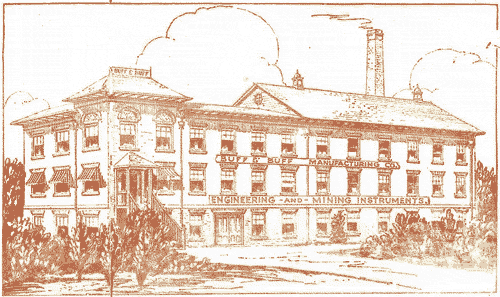Buff & Buff Manufacturing Company
Buff & Buff Manufacturing Company occupied the site of what is now the Buff Condominiums at 329R Lamartine Street in Jamaica Plain until the mid-1980’s. Buff & Buff manufactured and repaired a variety of precision engineering instruments, most notably surveying transits and theodolites.
Buff and Buff label, Image courtesy of Elise & Peter Pogorski
George Louis Buff started the company in 1898 with his son Louis, a transitman, after the dissolution of his previous enterprise, Buff & Berger, located at 9 Province Court in Boston. It seems George had plenty of experience in the precision instrument business, having worked for various instrument firms in his native Germany, and later in England and New York.
In 1900, the same year that George’s second son Carl joined Buff & Buff as a clerk, George applied for a building permit to construct a stone foundation, two-story brick building with a flat roof for light manufacturing on a portion of land he had bought in 1890, and where he currently resided. This encompassed what is now 23 Cheshire Street and 321-327 Lamartine. After 1901, ads in the Boston City directory gave the company’s address as 329 Lamartine. George and his wife Mary lived at 23 Cheshire together until her death from Brights disease (nephritis) in 1892 at the age of 47. George continued to live at 23 Cheshire until his death in 1923.
One of the critical pieces of equipment for making surveying instruments was called a circular dividing engine. George had two, one 28.5 inches in diameter which he built in 1899, and the other 48 inches in diameter, which he acquired in 1903. He had improved on earlier transit designs from 1866, calling his new product Buff’s Precise Transit, and, with the use of his dividing engines, manufactured it in his new factory for many years. For the cross-hairs on the instruments’ eyepieces, he used spider silk. Spiders were collected each year from the banks of the Charles River and kept in the factory’s basement on racks designed to encourage the spiders to spin silk onto reels for use in the factory.
Buff & Buff was incorporated in Massachusetts in 1904, but it wasn’t until 1907 that George deeded the rear portion of 325-327 Lamartine to the Buff & Buff Manufacturing Company. That same year, his eldest son Louis married and moved out of the house at 23 Cheshire. Shortly thereafter in 1908, Carl, not quite 31, died of typhoid fever. By 1909, George’s third son Henry had joined the company as a clerk. In 1918, they added a roofed wooden platform and steps to the factory building.
1926 ad for Buff & Buff products
When George died in 1923, Louis became President of Buff & Buff Manufacturing. In 1926, Louis added a one-story wooden addition on a concrete foundation to the factory and Henry became Vice President of Buff & Buff. By then, Louis was involved with several other companies, and remained President of both the Babson-Dow Manufacturing Company and the Henrici Laundry Machinery Company until he died in 1941.
Upon Louis’s death at age 65 from pancreatic cancer, Henry took over the reins. Henry, who never married and continued to reside at 23 Cheshire Street, presided over the company until 1975, when Frank Dow took over the position of President. Henry died of atherosclerosis in 1976, at the age of 91. Frank incorporated under the new name of Buff Instruments Corporation in 1979, but that company was involuntarily dissolved in 1983. Around 1984 a salvage operation was undertaken by the Liberty Tool Company and a multitude of parts, miscellaneous equipment and valuable lithographs were found in the old factory. Today these artifacts can be found in the Davistown Museum in Liberty Maine.
In the early 1970’s, Sheldon Weinstein and Warren Cossit acquired the land at 321-323, 325-327, and 329R Lamartine Street. In 1979, Anne Dow bought the parcels. She sold 325-327 Lamartine in 1981, and in 1985 a real estate trust bought the remaining lots. Use of the building that housed the Buff factory was first changed from light manufacturing to light manufacturing, artists’ studios and offices, and later to a six-family dwelling. The master deed for Buff condominiums, covering the land formerly occupied by Buff & Buff Manufacturing, was recorded in 1990.
References:
Davistown Museum
Two photographs of Buff & Buff transits, courtesy of Danielle Stone, may be viewed here:
photo1
photo2
A postcard sent by Buff & Buff to a customer:
By Chris Globig
Sources:
Birth, marriage and death data from Massachusetts State Archives.
Property data from Suffolk Registry of Deeds and Massachusetts State Archives.
Building data from Boston Inspectional Services permits


